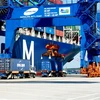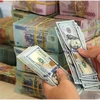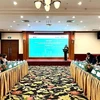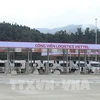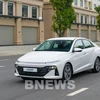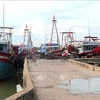The trend towards retail banking will only get stronger in Vietnam as banks realise the vast potential of the market, experts said at the ASEAN Banker Forum held on November 19 in Ho Chi Minh City.
"The experience of the monetary crisis in 1998-99 and 2007-08 showed mistakes. Commercial banks had invested a great deal in sectors that easily brought high profits such as real estate and security. They forgot retail, a potential, stable sector," Ha Huy Tuan, deputy chairman of the National Financial Supervisory Commission, told the forum.
Bankers, financial experts and technology consultants attending the forum agreed that the fast pace of urbanisation, the country's rising population and higher incomes, and an increasing number of small- and medium-sized enterprises (SMEs) had pushed the development of retail banking in the country.
During the one-day meeting, experts spoke about operational excellence and the need to differentiate and transform banking channels.
Tuan said the increase in population and income had created "much potential; moreover, 90 percent of companies in Vietnam are SMEs, a potential customer for the market".
"That's why developing retail banking is becoming the key strategy of banks and financial institutions," he said.
Le Cong, CEO of the Military Bank, said that only 30 percent of Vietnamese residents had been approached by banking services, and the remaining 70 percent represented a huge market for retail services.
Nguyen Tu Anh, CEO of the Smartlink Card Joint Stock Company, said that retail banking had become more important in the Vietnamese banking sector in the last three years.
"For big banks like Vietcombank and Vietinbank, capital mobilisation from the retail sector accounts for 50-55 percent. Meanwhile, the figure is more than 80 percent at smaller banks," she said.
Anh said the number of cards and banking accounts had continued to surge.
"As of June, there were about 50 million banking cards and many other payment tools. The payment network has also developed with more than 16,000 automated teller machines (ATMs). Many companies are accepting online payments. In addition, many other payment methods such as mobile banking are being used," she said.
Despite the potential, many participants said that competition was tough as the banking sector was one of the first to open to foreign players. They estimated that to win the market, banks must be able to differentiate themselves in services and products from their competitors.
The participants said that service payments and money transfers at banks in Vietnam were too similar and as a result customers did not distinguish between banks. They added that developing better management skills and investing more in information technology were two other necessary steps.
"Banks in Vietnam have to create differentiation and make big changes. They need to upgrade their distribution systems as well as services and products," said Tran Thi Hong Hanh, secretary general of the Vietnam Banks Association.
The ASEAN Banker Forum was co-organised by the association and International Data Group (IDG). This was its third annual meeting.
Outstanding Banking prizes
Six banks in Vietnam on November 19 were awarded the Vietnam Outstanding Banking Awards 2013 organised by IDG ASEAN and the Vietnam Banks Association.
The award honoured those banks that had achieved an outstanding performance and had contributed to the development of the banking and financial sector.
The title outstanding retail bank was bagged by Techcombank; outstanding e-banking award, Vietinbank; outstanding security initiative banking award, HDBank; outstanding trading platform banking award, Vietinbank; outstanding branch of foreign bank ward, CitiBank; and Oceanbank and TienPhong Bank, outstanding innovative banking products and services award.
The jury included representatives from government agencies, ministries, associations and experts in the fields of finance and banking technology.-VNA
"The experience of the monetary crisis in 1998-99 and 2007-08 showed mistakes. Commercial banks had invested a great deal in sectors that easily brought high profits such as real estate and security. They forgot retail, a potential, stable sector," Ha Huy Tuan, deputy chairman of the National Financial Supervisory Commission, told the forum.
Bankers, financial experts and technology consultants attending the forum agreed that the fast pace of urbanisation, the country's rising population and higher incomes, and an increasing number of small- and medium-sized enterprises (SMEs) had pushed the development of retail banking in the country.
During the one-day meeting, experts spoke about operational excellence and the need to differentiate and transform banking channels.
Tuan said the increase in population and income had created "much potential; moreover, 90 percent of companies in Vietnam are SMEs, a potential customer for the market".
"That's why developing retail banking is becoming the key strategy of banks and financial institutions," he said.
Le Cong, CEO of the Military Bank, said that only 30 percent of Vietnamese residents had been approached by banking services, and the remaining 70 percent represented a huge market for retail services.
Nguyen Tu Anh, CEO of the Smartlink Card Joint Stock Company, said that retail banking had become more important in the Vietnamese banking sector in the last three years.
"For big banks like Vietcombank and Vietinbank, capital mobilisation from the retail sector accounts for 50-55 percent. Meanwhile, the figure is more than 80 percent at smaller banks," she said.
Anh said the number of cards and banking accounts had continued to surge.
"As of June, there were about 50 million banking cards and many other payment tools. The payment network has also developed with more than 16,000 automated teller machines (ATMs). Many companies are accepting online payments. In addition, many other payment methods such as mobile banking are being used," she said.
Despite the potential, many participants said that competition was tough as the banking sector was one of the first to open to foreign players. They estimated that to win the market, banks must be able to differentiate themselves in services and products from their competitors.
The participants said that service payments and money transfers at banks in Vietnam were too similar and as a result customers did not distinguish between banks. They added that developing better management skills and investing more in information technology were two other necessary steps.
"Banks in Vietnam have to create differentiation and make big changes. They need to upgrade their distribution systems as well as services and products," said Tran Thi Hong Hanh, secretary general of the Vietnam Banks Association.
The ASEAN Banker Forum was co-organised by the association and International Data Group (IDG). This was its third annual meeting.
Outstanding Banking prizes
Six banks in Vietnam on November 19 were awarded the Vietnam Outstanding Banking Awards 2013 organised by IDG ASEAN and the Vietnam Banks Association.
The award honoured those banks that had achieved an outstanding performance and had contributed to the development of the banking and financial sector.
The title outstanding retail bank was bagged by Techcombank; outstanding e-banking award, Vietinbank; outstanding security initiative banking award, HDBank; outstanding trading platform banking award, Vietinbank; outstanding branch of foreign bank ward, CitiBank; and Oceanbank and TienPhong Bank, outstanding innovative banking products and services award.
The jury included representatives from government agencies, ministries, associations and experts in the fields of finance and banking technology.-VNA
